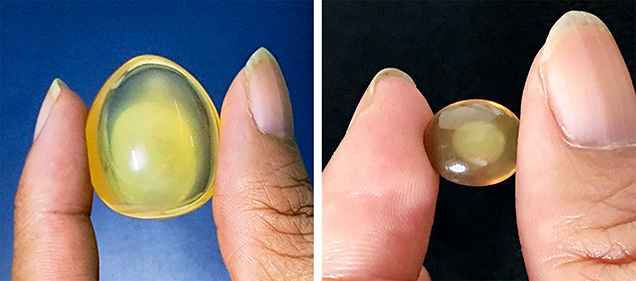A New Treatment: Creating Phantom Structure in Opal

Phantom structure in opal is a rare and interesting feature found only in Ethiopian opals (www.opalauctions.com/learn/opal-information/phantom-ghost-of-the-opal). The phantom consists of a large spherical inclusion, white and opaque, that is enclosed by transparent, yellow, or colorless host opal—whimsical names include “ghost,” “egg,” and “mother and daughter” opal. The exotic combination of precious opal surrounded by transparent opal renders this material more attractive and valuable. So far, there has been little research on its characteristics and formation.

At the end of 2021, while performing experiments on natural opal to test changes in transparency and the play-of-color effect with various solutions, the authors accidentally discovered how the phantom formed artificially in natural opal when immersing the stones in a mixture of water, oil, acetone, and other solutions (figure 1). As our curiosity continued to grow, we devised a treatment method to create a phantom in opal by adjusting the amount of solutions, time, and temperature. The phantom opal obtained by the treatment is visually similar to natural phantom opal (figure 2). The treatment is simple, but it creates a spectacular and bizarre structure that improves the stone’s appeal and value.
To reproduce the treatment process, we randomly selected an opal sample purchased from a jewelry store in Ho Chi Minh City (the seller did not know the gem’s origin). The oval cabochon weighing 19.0 ct was white in bodycolor and semitranslucent, with weak play-of-color (dull orange, yellow, green, and blue). The gem was tested before and after treatment using standard gemological methods and Fourier-transform infrared (FTIR) spectroscopy with a spectral range from 650 to 4000 cm–1 at Liu Gemological Research and Application Center. The refractive index was 1.45 (spot method), and the hydrostatic specific gravity was 1.72–1.85. The stone was inert to long- and short-wave ultraviolet radiation. Examination with a gemological microscope revealed many black inclusions that might be black magnetite. FTIR spectroscopy displayed major absorption bands at 779, 999, and 1638 cm–1. The gemological properties and FTIR analysis indicated natural opal.

After the gemological examination, the opal was soaked in a mixture of 90% vegetable oil and 5% ethanol, and the mixture was boiled at 80°C. Treatment time depended on the sample size and the expected size of the phantom. With longer heating time, more of the “phantom” was converted into transparent opal, resulting in a smaller center and larger surrounding transparent area. In this case, the author decided to treat the gem for 36 hours, and the finished artificial phantom was half the size of the host opal (figure 3). The shape of the phantom was similar to that of the host gemstone. Notably, the play-of-color area shrank after treatment. It went from covering the entire opal to just a thin layer at the outline of the phantom. Interestingly, the dull quality of the play-of-color did improve somewhat.

The characteristics of an opal sample before and after treatment are shown in table 1. Three distinct features can be used to identify the artificial phantom. The first is the morphological similarity between the host opal and its phantom. Second, the treated phantom opal strongly luminesces under long- and short-wave UV radiation as a result of the oil, while the natural opal is usually inert to weak green. Third, the FTIR spectra after treatment exhibit two additional significant peaks at 2853 and 2922 cm–1, attributed to the symmetric and asymmetric stretching vibration of the aliphatic CH2 group present in oil (N. Vlachos et al., “Applications of Fourier transform-infrared spectroscopy to edible oils,” Analytica Chimica Acta, Vol. 573–574, 2006, pp. 459–465). The third feature is also the most noticeable evidence that the sample has been treated with oil.
The treated sample was stored at room temperature under fluorescent lighting for three months to test the treatment’s stability. The phantom remained intact, leading the authors to conclude that the treatment stabilization is permanent under normal conditions. The apparent stability of the transparent opal may be explained by the impregnated oil in the stone, which evaporates slowly. To avoid damaging the treatment, however, careful handling is still advised when wearing a stone treated in this way.
In gem trading, treated products must be disclosed. Treated phantom opal may appear commercially in the future, so it is important to disclose our treatment process used to create a phantom structure by impregnating opal with oil and heat, as well as the means to identify the treatment. More importantly, this report is intended to avoid confusion between natural and treated phantom opal.
.jpg)


